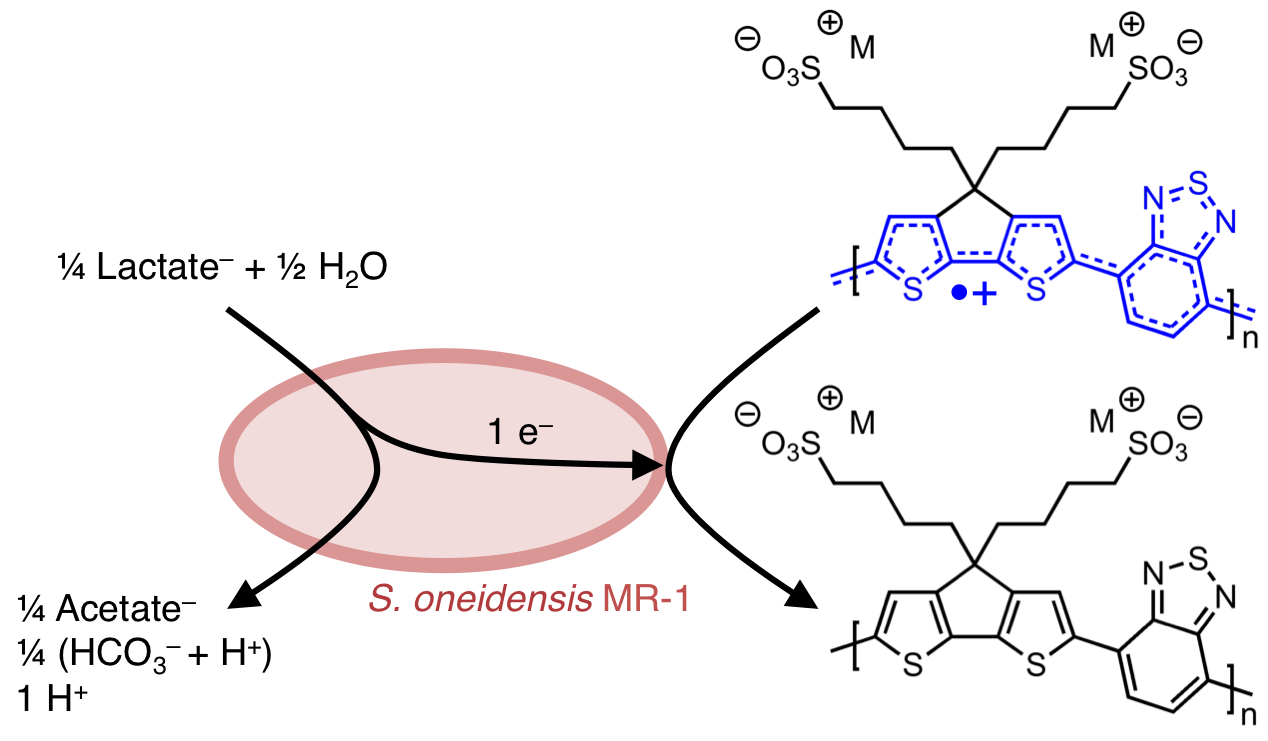Modification of Microbes with Conjugated Oligo- and Polyelectrolytes and Applications in Bioelectrochemical Devices
Microbial anaerobic respiration through the process of extracellular electron transfer to solid substrates, such as minerals, is a well-known and essential component of biogeochemical cycles. Some of the bacteria that participate in these cycles can also exchange electrons with electrodes and forms the basis of bioelectrochemical devices, including microbial fuel cells and bioelectrosynthesis platforms. The functional activity of bacteria in these devices is determined by diffusion of substrates, transfer of electrons between cells and the electrode, and fuel conversion efficiency. Materials for electrode/bacteria modification strategies are thus being sought to improve electron transfer from these exoelectrogenic bacteria.
In the Bazan group, we are pursuing two routes to improve electron transfer between microbes and the electrode. One is modifying the external environment with conjugated polyelectrolytes (CPEs). CPEs are defined by their ?-conjugated backbone and pendant ionic groups. Modulating the chemistry of the backbone enables tunability of charge transport and optical properties while the ionic groups afford solubility in aqueous media and also tune charge transport. In a survey of CPE structures, we found that adding self-p-doping CPE-K (pictured below) to microbial electrochemical cells can increase biocurrent generation three-fold.

Figure 1. CPE-K can act as an electron acceptor for Shewanella oneidensis MR-1 and improve the abiotic/biotic interface.
An improvement in electron transfer between bacteria and an external electrode can further be achieved by the spontaneous insertion of biocompatible, organic or organomettallic molecules (for example, see 1 and Figure 2A) across microbial membranes leading to the facilitation of cell–electrode interactions. This has important consequences for bio-based energy production and bioelectrosynthetic systems. We have demonstrated increased electricity generation in microbial fuel cells (Figure 2B) using electrode-attached modified microorganisms in comparison to their unmodified counterparts. Coupled with a reduction in the amount of organic substrate present in the fuel cell medium, we envision application of this cell modification strategy to wastewater treatment with concomitant production of useable electrical energy.


Figure 2 –(A) Confocal microscopy image of COE-stained E. coli. (B) Schematic representation of a microbial fuel cell employing molecular-wire-modified microbes for wastewater treatment and electrical power generation.
Conversely, by using an electrode as an electron donor, we have also demonstrated an influence in microbial metabolite production using modified microorganisms. This is potentially a unique route to carbon fixation and to obtaining value-added products from biological systems.
We are working to deepen our mechanistic understanding of the role of COE intercalation in stimulating cell–electrode interactions. Such insight is expected to guide future design of COEs with increased microbial specificity and increased charge extraction and injection efficiency.
